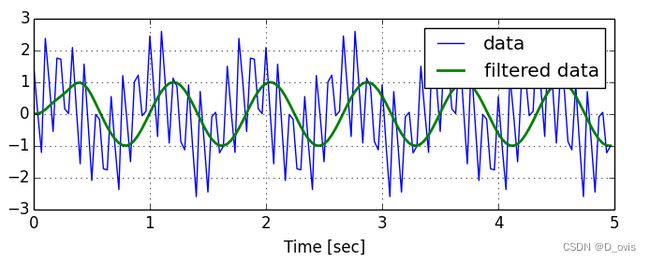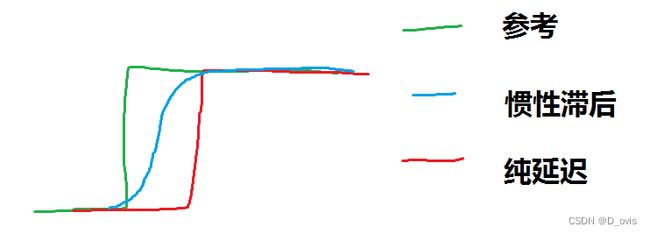数字滤波器(二)
6、限幅平均滤波法
逻辑:
相当于“限幅滤波法”+“递推平均滤波法”;
每次采样到的新数据先进行限幅处理,
再送入队列进行递推平均滤波处理。
优点:
融合了两种滤波法的优点;
对于偶然出现的脉冲性干扰,可消除由于脉冲干扰所引起的采样值偏差。
缺点:
比较浪费RAM。
#define FILTER_N 12
int Filter_Value;
int filter_buf[FILTER_N];
void setup() {
Serial.begin(9600); // 初始化串口通信
randomSeed(analogRead(0)); // 产生随机种子
filter_buf[FILTER_N - 2] = 300;
}
void loop() {
Filter_Value = Filter(); // 获得滤波器输出值
Serial.println(Filter_Value); // 串口输出
delay(50);
}
// 用于随机产生一个300左右的当前值
int Get_AD() {
return random(295, 305);
}
// 限幅平均滤波法
#define FILTER_A 1
int Filter() {
int i;
int filter_sum = 0;
filter_buf[FILTER_N - 1] = Get_AD();
if(((filter_buf[FILTER_N - 1] - filter_buf[FILTER_N - 2]) > FILTER_A) || ((filter_buf[FILTER_N - 2] - filter_buf[FILTER_N - 1]) > FILTER_A))
filter_buf[FILTER_N - 1] = filter_buf[FILTER_N - 2];
for(i = 0; i < FILTER_N - 1; i++) {
filter_buf = filter_buf[i + 1];
filter_sum += filter_buf;
}
return (int)filter_sum / (FILTER_N - 1);
}
7、一阶滞后滤波法
逻辑:
取a=0-1,本次滤波结果=(1-a)*本次采样值+a*上次滤波结果。
优点:
对周期性干扰具有良好的抑制作用;
适用于波动频率较高的场合。
缺点:
相位滞后,灵敏度低;
滞后程度取决于a值大小;
不能消除滤波频率高于采样频率1/2的干扰信号。
int Filter_Value;
int Value;
void setup() {
Serial.begin(9600); // 初始化串口通信
randomSeed(analogRead(0)); // 产生随机种子
Value = 300;
}
void loop() {
Filter_Value = Filter(); // 获得滤波器输出值
Serial.println(Filter_Value); // 串口输出
delay(50);
}
// 用于随机产生一个300左右的当前值
int Get_AD() {
return random(295, 305);
}
// 一阶滞后滤波法
#define FILTER_A 0.01
int Filter() {
int NewValue;
NewValue = Get_AD();
Value = (int)((float)NewValue * FILTER_A + (1.0 - FILTER_A) * (float)Value);
return Value;
}
8、加权递推平均滤波法
逻辑:
是对递推平均滤波法的改进,即不同时刻的数据加以不同的权;
通常是,越接近现时刻的数据,权取得越大。
给予新采样值的权系数越大,则灵敏度越高,但信号平滑度越低。
优点:
适用于有较大纯滞后时间常数的对象,和采样周期较短的系统。
缺点:
对于纯滞后时间常数较小、采样周期较长、变化缓慢的信号;
不能迅速反应系统当前所受干扰的严重程度,滤波效果差。
int Filter_Value;
void setup() {
Serial.begin(9600); // 初始化串口通信
randomSeed(analogRead(0)); // 产生随机种子
}
void loop() {
Filter_Value = Filter(); // 获得滤波器输出值
Serial.println(Filter_Value); // 串口输出
delay(50);
}
// 用于随机产生一个300左右的当前值
int Get_AD() {
return random(295, 305);
}
// 加权递推平均滤波法
#define FILTER_N 12
int coe[FILTER_N] = {1, 2, 3, 4, 5, 6, 7, 8, 9, 10, 11, 12}; // 加权系数表
int sum_coe = 1 + 2 + 3 + 4 + 5 + 6 + 7 + 8 + 9 + 10 + 11 + 12; // 加权系数和
int filter_buf[FILTER_N + 1];
int Filter() {
int i;
int filter_sum = 0;
filter_buf[FILTER_N] = Get_AD();
for(i = 0; i < FILTER_N; i++) {
filter_buf = filter_buf[i + 1]; // 所有数据左移,低位仍掉
filter_sum += filter_buf * coe;
}
filter_sum /= sum_coe;
return filter_sum;
}[/pre]
9、消抖滤波法
逻辑:
设置一个滤波计数器,将每次采样值与当前有效值比较:
如果采样值=当前有效值,则计数器清零;
如果采样值<>当前有效值,则计数器+1,并判断计数器是否>=上限N(溢出);
如果计数器溢出,则将本次值替换当前有效值,并清计数器。
优点:
对于变化缓慢的被测参数有较好的滤波效果;
可避免在临界值附近控制器的反复开/关跳动或显示器上数值抖动。
缺点:
对于快速变化的参数不宜;
如果在计数器溢出的那一次采样到的值恰好是干扰值,则会将干扰值当作有效值导入系统。
int Filter_Value;
int Value;
void setup() {
Serial.begin(9600); // 初始化串口通信
randomSeed(analogRead(0)); // 产生随机种子
Value = 300;
}
void loop() {
Filter_Value = Filter(); // 获得滤波器输出值
Serial.println(Filter_Value); // 串口输出
delay(50);
}
// 用于随机产生一个300左右的当前值
int Get_AD() {
return random(295, 305);
}
// 消抖滤波法
#define FILTER_N 12
int i = 0;
int Filter() {
int new_value;
new_value = Get_AD();
if(Value != new_value) {
i++;
if(i > FILTER_N) {
i = 0;
Value = new_value;
}
}
else
i = 0;
return Value;
}
10、限幅消抖滤波法
逻辑:
相当于“限幅滤波法”+“消抖滤波法”;
先限幅,后消抖。
优点:
继承了“限幅”和“消抖”的优点;
改进了“消抖滤波法”中的某些缺陷,避免将干扰值导入系统。
缺点:
对于快速变化的参数不宜。
int Filter_Value;
int Value;
void setup() {
Serial.begin(9600); // 初始化串口通信
randomSeed(analogRead(0)); // 产生随机种子
Value = 300;
}
void loop() {
Filter_Value = Filter(); // 获得滤波器输出值
Serial.println(Filter_Value); // 串口输出
delay(50);
}
// 用于随机产生一个300左右的当前值
int Get_AD() {
return random(295, 305);
}
// 限幅消抖滤波法
#define FILTER_A 1
#define FILTER_N 5
int i = 0;
int Filter() {
int NewValue;
int new_value;
NewValue = Get_AD();
if(((NewValue - Value) > FILTER_A) || ((Value - NewValue) > FILTER_A))
new_value = Value;
else
new_value = NewValue;
if(Value != new_value) {
i++;
if(i > FILTER_N) {
i = 0;
Value = new_value;
}
}
else
i = 0;
return Value;
}


